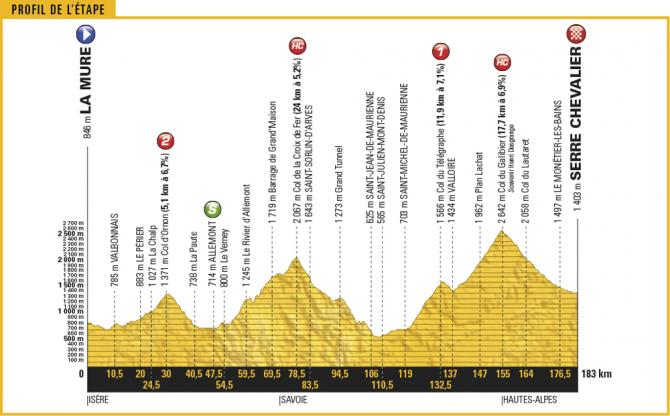Tour de France 2017: Stage 17 preview
La Mure to Serre-Chevalier, 183km
Here we go: the Alps. The first Tour de France stage of the final mountain range gets going in La Mure, a modest town south of Grenoble, whose claim to fame is being the penultimate stop on the Route Napoléon.
The stage heads east, further into the Isère département before turning north for the cat-two Col d'Ornon. The Ornon is the gateway to the classic Alpine terrain of the Tour. To the northwest is the magnificent Belledonne Massif, with its hydroelectric dams. To the east: the peaks and ski complexes of Alpe d'Huez on the Grandes Rousses massif. The Alpe isn't on the agenda, though this stage does visit two behemoths. The first is the Col de la Croix de Fer, via the western ascent which it shares, for the most part, with the Col du Glandon. Despite a couple of downhill sections offering some reprieve, it's a hard climb, and at 24km it's long. Its gradient also varies and the 5.2 per cent average includes those descents and veils long sections at nine, 10, even 11 per cent. And that's just an hors-categorie hors d'oeuvre to a very indigestible main course, an ascent of the Col du Galibier via the Télégraphe. From the bottom in Saint-Jean-de-Maurienne to the top of the Galibier, the roof of the Tour at 2,645m, is 35km of upward progress. The Télégraphe KoM and the 3km descent thereafter means they're separate beasts, but there's barely time to catch breath between them. This will be the first ascent of the Galibier since 2011 - the longest fallow period in the climb's history. It was due to be used in 2015, but a landslide meant the race was re-routed over the Croix de Fer. After a quite technical 8km descent to the junction with the top of the Lauteret, it's almost arrow straight on the schuss to Serre Chevalier.
To subscribe to Procycling click here.
Cadel Evans says
"There is a good chance of the breakaway staying away for this stage. The last time I raced the Col du Télégraphe and Col du Galibier from that side was during the 2013 Giro d'Italia, but the main thing in this stage will be the amount of climbing before the Télégraphe and the Galibier and that it is also the third week. Everyone is going to start the stage tired, and you are going to have a hard start and hard finish. Everyone is going to be exhausted which is another reason why I think the breakaway will stay away.
"We may see some close racing because everyone will be digging into the reserves. The Télégraphe and Galibier in my mind is probably the longest climb in Europe, not because it is the longest technically, but that from the top of the Télégraphe descent to the start of the Galibier passes so quickly in time. You get over the top, have a drink and start climbing again. There is very little respite in what is otherwise a 42km climb.
"The descent isn't that intimidating. On TV and from the helicopter I think it looks more intimidating. Obviously, it is a rough road, there are no barriers and it is very narrow with long straights with sharp switchbacks. The fact that the stage finishes with a downhill, I would expect to see a little bit of regrouping of the guys who go over the top. The stage will be decided by a small group finish, whether it's the breakaway or the GC guys."
Route profile

Route map

The latest race content, interviews, features, reviews and expert buying guides, direct to your inbox!
Latest on Cyclingnews
-
Why is Jonas Vingegaard the only rider on his team to wear a red helmet at the Tour de France?
The Visma-Lease a Bike team leader is the only one wearing the red and white Giro helmet -
Lauren Stephens fully committed to Aegis Foundation Cycling women's team as it heads toward 2026 rebrand as Next Step Racing
'I've always wanted to start a team' says two-time US gravel national champion who targets first-time appearance at Leadville Trail 100 MTB in August -
Amazon Prime Day Bike Deals Live: 33% off Garmin computers, Electric pumps and Tacx smart trainers
Deals on Canyon electric bikes, Adidas shoes, AirPods and more. Day three of Amazon Prime Day is here, and the sale is heating up -
Airpods Pro 2 vs Pixel Buds Pro 2: Battle of the Amazon Prime Day deals
With both options on offer for Amazon Prime Day, which should you part with your money for?




